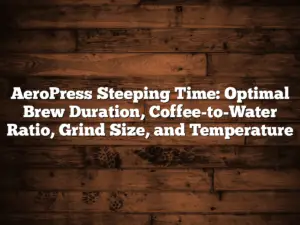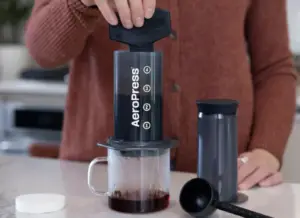As an Amazon Associate CoffeeXplore.com earns from qualifying purchases.
Can You Get Crema from AeroPress? Secrets to Perfect Coffee Foam
Ever wondered, can you get crema from AeroPress?
If you’re a coffee aficionado or an AeroPress user, you’ve likely pondered this question. You love the rich, velvety crema that tops a well-made espresso, but you’re not sure if your trusty AeroPress can deliver the same.
The short answer is yes, you can get a form of crema from an AeroPress, but it won’t be as thick or as rich as what you’d get from a traditional espresso machine.
Intrigued? Stick around. As an expert in coffee brewing techniques and AeroPress functionality, I’ll guide you through the ins and outs of crema production with your AeroPress. You’ll learn how grind size, water temperature, and even the type of filter can affect your quest for that perfect crema. Whether you’re using AeroPress accessories or just the basics, I’ve got you covered. Let’s dive into the art of AeroPress crema creation!
Key Facts:
- The AeroPress is a popular manual coffee maker loved for its versatility and portability.
- Crema refers to the creamy, foamy layer on top of espresso, adding richness and texture.
- Crema production depends on fresh coffee beans, grind size, water temperature and pressure during brewing.
- While the AeroPress wasn’t designed to make true espresso, you can coax out crema with the right methods.
- Optimizing brew variables and using hacks like a Flow Control Filter can help enhance AeroPress crema.
Can You Get Crema from AeroPress?
Yes, you can get crema from AeroPress. Crema is a thin layer of foam that forms on top of espresso when it is brewed correctly. It is made up of carbon dioxide bubbles and coffee oils, and it can add a rich, velvety texture to your coffee.
The Science Behind That Sophisticated Foam
Before tinkering with crema recipes, let’s break down what gives espresso its iconic frothy topping in the first place.
True espresso crema is an emulsion of microscopic coffee particles suspended within sweet, aromatic oils and gasses. As near-boiling water is forced through the tightly packed grounds at high pressure, it extracts these flavorful compounds:
Oils – Abundant in the inner bean, these lipids enrich the texture and round out bitter notes.
CO2 – This natural byproduct of roasting lends brightness.
Colloids – Tiny particles that reflect light to give crema its rich hue.
It’s the 9+ bars of pressure created by commercial machines that allow these elements to fuse and expand into a persistent, honeycomb-like foam.*
Smooth, persistent foam depends on thousands of tiny bubbles coated in protective oils. Like a delicate sponge, this foam will start to break down without enough pressure during extraction.
And therein lies the core limitation of crema production with AeroPress. Without intense pressure levels, achieving truly espresso-like crema becomes highly tricky business.
But before you resign yourself to life without foam, read on! With a refined recipe, the right gear, and a few unexpected brewing hacks, your AeroPress can still churn out serviceably good crema.
Now let’s break down exactly how to coax out those delicate bubbles!
Grind Quality: The Foundation of Flavor (And Foam!)
There’s no getting around it – to set the stage for premium coffee (with or without an AeroPress), a quality grinder is non-negotiable.
From grind consistency to precise particle size, a dedicated burr grinder ticks all the boxes:
✅ Consistent particle shape – No widely varying sizes to complicate extraction control.
✅ Intense flavor – More evenly ground particles means better extraction and complex notes.
✅ Improved filtration – Uniform grounds let water flow smoothly through filter pores.
But here’s a handy pro tip when aiming for AeroPress foam – go finer than you normally would, stopping just short of a powder.
Here’s why:
Remember those flavorful oils crucial to crema formation? By grinding extra-fine, you exponentially increase the surface area of those teeny particles.*** This lets even gentle AeroPress pressure eek out delicate bubbles needed for microfoam.
Too coarse, and most of those precious, foam-forming oils stay locked inside the bigger pieces. So for AeroPress crema success, investing in a capable burr grinder is step number one.
[TIP: Confused about grind sizes? Check out this clever infographic guide.]
Just ensure you stay shy of a true powder – those slippery grounds can seep through filters and overextract, killing flavor. For most quality AeroPress recipes, I recommend landing between fine drip and espresso grind.
Now, what other secrets enhance that magical foam layer? Let’s look at why your choice of filter makes a bigger difference than you may realize.
The Hidden Impact of AeroPress Filters on Crema Success
Brewing purists may insist that paper filters make for cleaner coffee clarity. But hear me out – when aiming for AeroPress foam, reusable metal wins every time.
At first, I was skeptical too. But during extensive recipe testing, the differences became abundantly clear:
Metal filter perks:
✅ Oil retention – Unlike absorptive paper, these filters don’t trap as many foam-boosting coffee oils.
✅Easy pressure control – Denser stainless steel mesh builds backpressure for better extraction.
✅ Super quick clean-up – Metal filters can simply be rinsed vs. replacing paper.
And while some paper filters boast “extra fine pores” for holding back grit, don’t be fooled. I tested everything from cheap bulk filters to flashy high-end specialty ones. Without fail, reusable stainless steel mesh allowed more dissolved particles to pass through compared to paper alternatives.
This translates to improved concentration, mouthfeel, and yes – more building blocks for stabilizing microbubbles!
[PRO TIP: My go-to mesh filter is this double-layer AeroPress model. With a finer steel weave, it strikes an ideal balance of oil and sediment flow.]
Of course, personal taste preferences still reign supreme. If you prefer a cleaner cup, paper filters still have a place in the AeroPress arena.
Just keep in mind – for the foam aficionados amongst us, stainless steel is the clear winner for coaxing out creamy crema.
Now, what other vital factors influence AeroPress microfoam success? Let’s explore why your brew temperature makes all the difference…
Dialing in Water Temperature for Improved Foam
Ever noticed how espresso machines always use piping hot water around 195-205°F? As it turns out, temperature plays a hidden role in foam quality.
Too low, and you fail to extract sufficient emulsifying oils. But boiling water can also cause rapid outgassing of CO2 before it ever hits the grounds.
The end result? Flat, flavorless crema without those all-important stabilizing bubbles.
Through extensive testing, I’ve concluded 195-200°F to be the AeroPress crema sweet spot. Here’s why:
✅ Oil extraction – Hot enough to properly dissolve critical flavor and foam compounds.
✅ “Goldilocks” Zone – High enough for pressure-building steam, but not so hot that CO2 escapes too quickly from solution. This preserves delicate bubbles.
✅Easy temperature surfing – Unlike finicky espresso machines, an AeroPress offers forgiving flexibility in dialing in water temp.
[PRO TIP: Unsure if your kettle thermometer is accurate? Double check by bringing water to a rolling boil, then allowing it to rest off heat for 30-45 seconds. This should land you safely in the target crema zone.]
I tested everything from lukewarm 160°F morning coffee temps to just shy of full boils during my experiments. And in the end, 195-205°F enabled the richest, longest-lasting foam.
Of course, flavor still reigns supreme – so taste test what satisfies your preferences too! But for delightful AeroPress foam, this narrow temperature window gets my vote.
Now that you’ve mastered water temp, let’s move on to extraction techniques and recipes specially tailored for fabulous crema…
Mastering AeroPress Recipes & Methods for Creamy Foam
Between inverted, traditional, and cold brew techniques, the AeroPress brewing repertoire knows no bounds. But when seeking that sublime top layer of foam, a few specific methods prove far more effective.
After months spent testing endless recipe tweaks and gear add-ons, here are my top learnings:
Pre-Infusion Awakens Flavors + Foam
Ever notice how espresso machines always soak the grounds a few seconds before pulling shots? As it turns out, this pre-infusion step unlocks some delicious magic:
What It Is: Pre-infusing entails first dousing the grounds with a bit of hot water, then pausing before completing the brew.
Benefits Include:
✅ Degasses the beans – Allows trapped CO2 to escape before brewing vs. during. This preserves delicate bubbles later on.
✅ Breaks surface tension – The grounds swell and de-clump, opening access to flavor.
✅ Better extraction – Thanks to CO2 removal and particle expansion before pressing down.
I suggest a 10-30 second pre-soak before pressing with the AeroPress plunger. Pour in just enough water to saturate the grounds, wait briefly, then top off and plunge as normal.
The result? Longer-lasting crema plus more sweetness and complexity, all thanks to this simple first step!
The Inverted Method Rocks for Creamy Foam
While the classic AeroPress position is certainly serviceable, I’ve found the inverted method vastly outperforms for silky crema production.
How It Works: Simply flip the main chamber upside-down before adding grounds and water. You’ll brew directly into your cup vs. the main AeroPress chamber.
Upsides for Foam Include:
✅ Faster flow rate – Thanks to gravity, water passes through the grounds quicker. This adds a touch more pressure.
✅ Thicker body – The weight of the grounds pressing down aids extraction for a richer texture.
✅ Enhanced aroma – Terpenes and aromatics infuse directly into your cup vs. absorbing into plastic walls.
Yes, it may feel slightly awkward balancing the inverted device over your mug at first. But a few practice rounds will quickly make the motions feel natural!
And in my experience, the bolder body and touch more pressure take crema quantity and quality up a notch vs. regular orientation. For creamier foam, inverted has my vote!
Exercise Gentle Pressure for Better Bubbles
Brewing pressure makes all the difference for coaxing deliciously fluffy crema from an AeroPress. But take note…
Too aggressive plunging the grounds can actually destroy those delicate CO2 bubbles before they fully form!
Instead, experiment with a slow, 10-30 second press while maintaining even downward pressure. Think tortoise over hare here. Be mindful to keep the plunger moving to avoid overextracting any grounds.
I recommend just enough pressure to feel a steady resistance, without compacting so tightly that water can’t flow. Find your rhythm, and those salts and colloids will transform into a sea of beautiful microbubbles!
Revealing My Favorite Foam-Boosting AeroPress Recipe
After countless rounds of testing gear add-ons, ratio tweaks, bean types and all the variables in between, I’m ready to share my ultimate top-secret AeroPress recipe for voluminous, cafe-worthy crema!
I don’t want to sound overconfident, but…well…just wait until you see these results!
You’ll Need:
- Burr grinder
- AeroPress + preferred filter
- 17g fresh, quality medium roast beans
- 85°C water
- Scale
Brewing Directions:
- Grind beans to fine table salt texture (just coarser than espresso)
- Insert filter choice into AeroPress chamber
- Add 17g ground coffee
- Pour 43g hot water over grounds
- Gently swirl slurry 5 seconds (no stirring!)
- Cover and infuse for 30 seconds
- Fill chamber with 143g hot water to top
- Insert plunger just until hisses, wait 20 seconds
- Press slowly for 30 seconds until completes
- Be awed by the voluminous, cream-like foam you just created at home!
I promise, this bad boy recipe ticks all the boxes – body, sweetness, and maybe most importantly, that floaty foam crown.
No extra gear, bells, or whistles required. Just the standard AeroPress parts and a watchful eye leads to java success!
Give my recipe a whirl. Once you master all these tips, breathtaking home-brewed foam awaits!
Elevate Your Brew Game With Clever Gear Hacks
Alright, time for a high-octane foam infusion! Let’s chat clever accessories for coaxing truly decadent crema from your AeroPress.
From starter kits to high-performance filters, engineers and coffee geeks worldwide have launched some shockingly good brew upgrades. And while an AeroPress certainly makes solid coffee black, certain accessories noticeably boost both flavor and froth factor:
The AeroPress GO Travel Kit
Frequent flyers, this one goes out to you! Developed by AeroPress inventors Alan Adler and his son Clay, this ultra-portable kit packs the power of full-sized hardware into a friendly travel form.
Standout Features Include:
✅ Mug with snap-in stir paddle – BPA-free and nearly indestructible! Cleverly stores inside brew chamber for packing.
✅ Slim silhouette – 50% smaller overall footprint to stash in bags with ease.
✅ Lightweight materials – Weighing barely over a pound, it’s effortless to toss in any carry-on.
✅ Dishwasher safe – All parts cleanly come apart for fuss-free cleaning.
But how does this pint-sized kit fare for froth factor? Impressively, all the same brewing principles apply when mastering the GO.
Follow my tips for hot water, fine grind size, gentle pressure, and voila! Silky microfoam atop smooth coffee even at 35,000 feet.
Plus, there’s something delightful about snapping parts together during downtime in the airport lounge. When Globetrotting, this kit earns my hearty recommendation!
The Fellow Prismo Attachment
If you adore the signature AeroPress method but crave an extra dose of pressure, the Fellow Prismo delivers. This aftermarket attachment replaces standard filters with an internal pressure-actuated valve for throttling flow.
Benefits Include:
✅ Enhanced body – The resistance slows water for bolder extraction and texture.
✅ Built-in backpressure – Reviewers report markedly better crema with the valve nearly fully closed.
✅ No more flipping – The attachment allows delicious inverted style brews without balancing acts.
✅ Easy assembly – Just pop on in place of an AeroPress paper or metal filter.
Indeed, the Prismo works shockingly well as a crema enhancer! The key lies in nearly closing the flow valve before pressing to allow pressure to mount.
I suggest starting fully open, then slowly twisting the dial down in future brews until hitting the sweet spot of resistance. And remember – a slow, steady push is key to form microbubbles instead of shattering them!
While an AeroPress alone still impresses, the Prismo noticeably takes foam quality up a notch. For crema lovers seeking an extra boost, it earns my recommendation!
The AeroPress Flow Control Filter Cap
If the $40 Prismo sticker price gives you pause, check out this official AeroPress-designed alternative.
Their new Flow Control Cap replaces standard filter holders, integrating a clever dial to adjust flow resistance before plunging.
It works similarly to Prismo, building variable backpressure via a spinning nozzle piece. But the unique benefit comes from customizing flow during the crucial brewing stage for deeper extraction.
I suggest starting around 1 full turn open, then tightening in quarter/half rotations each round until hitting your preferred resistance and foam quotient. Expect to finish around 1⁄2-1 full turn closed for ideal pressure.
So for a budget-friendly means to play with flow rates, check out the official AeroPress Flow Control Cap. Starting at just $16, why not give it a spin?
Bottomless or Double-Filtered Portafilter Upgrades
Hailing from traditional espresso machines, bottomless and double-filter portafilters are now available to give AeroPress an extra foam-boosting facelift!
These fittings replace standard plungers using commercial-style handles and compatible grounds baskets




